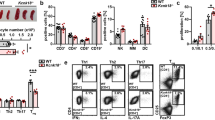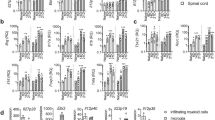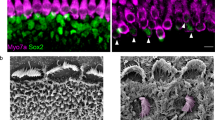Abstract
Interleukin-10 (IL-10) has an important role in the homeostatic regulation of autoreactive T-cell repertoire. We hypothesized that endogenous IL-10 would regulate the severity of β-tubulin-induced experimental autoimmune hearing loss (EAHL) and that exogenous IL-10 would abrogate it. BALB/c wild-type (WT) and homozygous IL-10-deficient mice (IL-10−/−) underwent β-tubulin immunization to develop EAHL; some IL-10 mice with EAHL were administered IL-10 DNA at the peak of EAHL. Auditory brainstem responses were examined over time. EAHL developed progressively in both WT and IL-10−/− mice. However, the severity of hearing loss in the IL-10−/− mice was significantly greater than that in WT animals. Moreover, disease severity was associated with a significantly enhanced interferon-γ level and loss of hair cells in IL-10−/− mice. IL-10 administered to EAHL IL-10−/− mice promoted IL-10 expression. Consequently, hearing significantly improved by protecting hair cells in established EAHL. Importantly, IL-10 treatment suppressed proliferation of antigen-specific T-helper type 1 (Th1) cells, and the suppression can be attributed to inducing IL-10-secreting regulatory T cells that suppressed autoreactive T cells. We demonstrated that the lack of IL-10 exacerbated hearing loss, and the exogenous administration of IL-10 improved hearing. Mechanistically, our results indicate that IL-10 is capable of controlling autoimmune reaction severity by suppressing Th1-type proinflammatory responses and inducing IL-10-secreting regulatory T cells.
This is a preview of subscription content, access via your institution
Access options
Subscribe to this journal
Receive 12 print issues and online access
$259.00 per year
only $21.58 per issue
Buy this article
- Purchase on Springer Link
- Instant access to full article PDF
Prices may be subject to local taxes which are calculated during checkout






Similar content being viewed by others
References
McCabe BF . Autoimmune sensorineural hearing loss. Ann Otol Rhinol Laryngol 1979; 88: 585–589.
Buniel MC, Geelan-Hansen K, Weber PC, Tuohy VK . Immunosuppressive therapy for autoimmune inner ear disease. Immunotherapy 2009; 1: 425–434.
Baek MJ, Park HM, Johnson JM, Altuntas CZ, Jane-Wit D, Jaini R et al. Increased frequencies of cochlin-specific T cells in patients with autoimmune sensorineural hearing loss. J Immunol 2009; 15: 4203–4210.
Billings PB, Keithley EM, Harris JP . Evidence linking the 68 kilodalton antigen identified in progressive sensorineural hearing loss patient sera with heat shock protein 70. Ann Otol Rhinol Laryngol 1995; 104: 181–188.
Billings PB, Shin SO, Harris JP . Assessing the role of anti-hsp70 in cochlear impairment. Hear Res 1998; 126: 210–213.
Yoo TJ, Yazawa Y, Tomoda K, Floyd R . Type II collagen-induced autoimmune endolymphatic hydrops in guinea pig. Science 1983; 222: 65–67.
Solares CA, Edling AE, Johnson JM, Baek MJ, Hirose K, Hughes GB et al. Murine autoimmune hearing loss mediated by CD4+ T cells specific for inner ear peptides. J Clin Invest 2004; 113: 1210–1217.
Zhou B, Kermany MH, Glickstein J, Cai Q, Cai C, Zhou Y et al. Murine autoimmune hearing loss mediated by CD4(+)T cells specific for β-tubulin. Clin Immunol 2011; 138: 222–230.
Yoo TJ, Shea Jr J, Ge X, Kwon SS, Yazawa Y, Sener O et al. Presence of autoantibodies in the sera of Meniere's disease. Ann Otol Rhinol Laryngol 2001; 110: 425–429.
Yoo TJ, Tanaka H, Kwon SS, Krug M, Yazawa Y, Suzuki M et al. tubulin as an autoantigen for autoimmune inner ear disease. Meniere's Dis 2002; 1999-Update: 529–535.
Yoo TJ, Du X, Kwon SS . Molecular mechanism of autoimmune hearing loss. Acta Otolaryngol Suppl 2002; 548: 3–9.
Du X, Yoo TJ, Mora R . Distribution of beta-tubulin in guinea pig inner ear. ORL J Otorhinolaryngol Relat Spec 2003; 65: 7–16.
Cai Q, Du X, Zhou B, Cai C, Kermany MH, Yoo T . Induction of tolerance by oral administration of beta-tubulin in an animal model of autoimmune inner ear disease. ORL J Otorhinolaryngol Relat Spec 2009; 71: 135–141.
Hughes GB, Barna BP, Kinney SE, Calabrese LH, Nalepa NL . Predictive value of laboratory tests in ‘autoimmune’ inner ear disease: preliminary report. Laryngoscope 1986; 96: 502–505.
Lorenz RR, Solares CA, Williams P, Sikora J, Pelfrey CM, Hughes GB et al. Interferon-gamma production to inner ear antigens by T cells from patients with autoimmune sensorineural hearing loss. J Neuroimmunol 2002; 130: 173–178.
Gloddek B, Gloddek J, Arnold W . Induction of an inner-ear-specific autoreactive T-cell line for the diagnostic evaluation of an autoimmune disease of the inner ear. Ann NY Acad Sc 1997; 830: 266–276.
Gloddek B, Gloddek J, Arnold W . A rat T-cell line that mediates autoimmune disease of the inner ear in the Lewis rat. ORL J Otorhinolaryngol Relat Spec 1999; 61: 181–187.
Wing K, Sakaguchi S . Regulatory T cells exert checks and balances on self tolerance and autoimmunity. Nat Immunol 2010; 11: 7–13.
Wan YY . Regulatory T cells: immune suppression and beyond. Cell Mol Immunol 2010; 7: 204–210.
Shimizu J, Yamazaki S, Takahashi T, Ishida Y, Sakaguchi S . Stimulation of CD25+CD4+ regulatory T cells through GITR breaks immunological self-tolerance. Nat Immun 2002; 3: 135–142.
Groux H, O’Garra A, Bigler M, Rouleau M, Antonenko S, de Vries JE et al. A CD4+ T-cell subset inhibits antigen-specific T-cell responses and prevents colitis. Nature 1997; 389: 737–742.
Sakaguchi S, Yamaguchi T, Nomura T, Ono M . Regulatory T cells and immune tolerance. Cell 2008; 133: 775–787.
Antony PA, Restifo NP . CD4+CD25+ T regulatory cells, immunotherapy of cancer, and interleukin-2. J Immunother 2005; 28: 120–128.
Oldenhove G, de Heusch M, Urbain-Vansanten G, Urbain J, Maliszewski C, Leo O et al. CD4+CD25+ regulatory T cells control T helper cell type 1 responses to foreign antigens induced by mature dendritic cells in vivo. J Exp Med 2003; 198: 259–266.
Yang ZZ, Novak AJ, Stenson MJ, Witzig TE, Ansell SM . Intratumoral CD4+CD25+ regulatory T-cell-mediated suppression of infiltrating CD4+ T cells in B-cell non-Hodgkin lymphoma. Blood 2006; 107: 3639–3646.
Lin W, Truong N, Grossman WJ, Haribhai D, Williams CB, Wang J et al. Allergic dysregulation and hyperimmunoglobulinemia E in Foxp3 mutant mice. J Allergy Clin Immunol 2005; 116: 1106–1115.
Kim JM, Rudenky A . The role of the transcription for Foxp3 in the development of regulatory T cells. Immunol Rev 2006; 212: 86–92.
Bacchetta R, Passerini L, Gambineri E, Dai M, Allan SE, Perroni L et al. Defective regulatory and effector T cell functions in patients with FOXP3 mutations. J Clin Invest 2006; 116: 1713–1722.
Bluestone JA . Regulatory T-cell therapy: is it ready for the clinic? Nat Rev Immunol 2005; 5: 343–349.
Anderson AC, Reddy J, Nazareno R, Sobel RA, Nicholson LB, Kuchroo VK . IL-10 plays an important role in the homeostatic regulation of the autoreactive repertoire in naive mice. J Immunol 2004; 173: 828–834.
Groux H, Bigler M, de Vries JE, Roncarolo MG . Interleukin-10 induces a long-term antigen-specific anergic state in human CD4+ T cells. J Exp Med 1996; 184: 19–29.
Steinbrink K, Wolfl M, Jonuleit H, Knop J, Enk AH . Induction of tolerance by IL-10-treated dendritic cells. J Immunol 1997; 159: 4772–4780.
Finnegan A, Kaplan CD, Cao Y, Eibel H, Glant TT, Zhang J . Collagen-induced arthritis is exacerbated in IL-10-deficient mice. Arthritis Res Ther 2003; 5: 18–24.
Fellowes R, Etheridge CJ, Coade S, Cooper RG, Stewart L, Miller AD et al. Amelioration of established collagen induced arthritis by systemic IL-10 gene delivery. Gene Therapy 2000; 7: 967–977.
Maynard CL, Weaver CT . Diversity in the contribution of interleukin-10 to T-cell-mediated immune regulation. Immunol Rev 2008; 226: 219–233.
Guichelaar T, ten Brink CB, van Kooten PJ, Berlo SE, Broeren CP, van Eden W et al. Autoantigen-specific IL-10-transduced T cells suppress chronic arthritis by promoting the endogenous regulatory IL-10 response. J Immunol 2008; 180: 1373–1381.
Wilczynski JR, Radwan M, Kalinka J . The characterization and role of regulatory T cells in immune reactions. Front Biosci 2008; 13: 2266–2274.
Roncarolo MG, Gregori S, Battaglia M, Bacchetta R, Fleischhauer K, Levings MK . Interleukin-10-secreting type 1 regulatory T cells in rodents and humans. Immunol Rev 2006; 212: 28–50.
Johansson AC, Hansson AS, Nandakumar KS, Backlund J, Holmdahl R . IL-10-deficient B10.Q mice develop more severe collagen-induced arthritis, but are protected from arthritis induced with anti-type II collagen antibodies. J Immunol 2001; 167: 3505–3512.
Ortmann RA, Shevach EM . Susceptibility to collagen-induced arthritis: cytokine-mediated regulation. Clin Immunol 2001; 98: 109.
Cuzzocrea S, Mazzon E, Dugo L, Serraino I, Britti D, De Maio M et al. Absence of endogenous interleukin-10 enhances the evolution of murine type-II collagen-induced arthritis. Eur Cytokine Netw 2001; 12: 568.
Akdis M, Blaser K, Akdis CA . T regulatory cells in allergy: novel concepts in the pathogenesis, prevention, and treatment of allergic diseases. J Allergy Clin Immunol 2005; 116: 961–968.
Acknowledgements
This study was supported by RO1 Grant from NIH: NIH-NIDCDRO1-DCO05010-01-A2.
Author information
Authors and Affiliations
Corresponding author
Ethics declarations
Competing interests
The authors declare no conflict of interest.
Rights and permissions
About this article
Cite this article
Zhou, B., Kermany, M., Cai, Q. et al. Experimental autoimmune hearing loss is exacerbated in IL-10-deficient mice and reversed by IL-10 gene transfer. Gene Ther 19, 228–235 (2012). https://doi.org/10.1038/gt.2011.88
Received:
Revised:
Accepted:
Published:
Issue Date:
DOI: https://doi.org/10.1038/gt.2011.88



